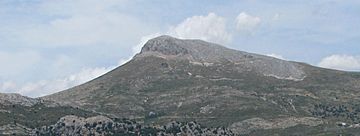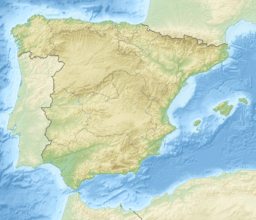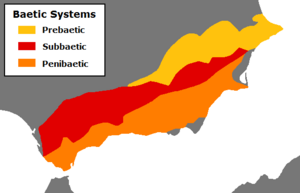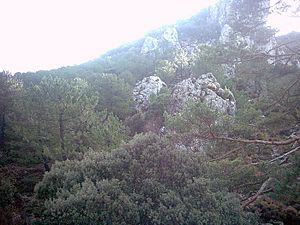Subbaetic System facts for kids
Quick facts for kids Subbaetic System |
|
|---|---|
| Sistema Subbético | |

Peña de la Cruz, the highest peak in the Sierra Arana
|
|
| Highest point | |
| Peak | Peña de la Cruz |
| Elevation | 2,027 m (6,650 ft) |
| Dimensions | |
| Length | 510 km (320 mi) ENE/WSW |
| Width | 60 km (37 mi) NNW/SSE |
| Geography | |
| Location | Andalusia / Murcia |
| Country | Spain |
| Range coordinates | 37°33′0″N 3°22′0″W / 37.55000°N 3.36667°W |
| Parent range | Baetic System |
| Geology | |
| Orogeny | Alpine orogeny |
| Age of rock | Cenozoic |
| Type of rock | Limestone |
The Subbaetic System (also called Sistema Subbético in Spanish) is a group of mountain ranges in southern Spain. It's one of three main parts of the larger Baetic System. These mountains are found in the southern part of the Iberian Peninsula.
The highest point in the Subbaetic System is Peña de la Cruz. This peak reaches 2,027 meters (about 6,650 feet) high. It is located in the Sierra Arana mountain range. To its north, you'll find the valley of the Guadalquivir river in the western area.
Contents
Where are the Subbaetic Mountains?
The Subbaetic System stretches across southern Spain. It starts near Cape Trafalgar in Cádiz Province. From there, it goes through the region of Andalusia and reaches into the Region of Murcia. These mountains are located just north of another range called the Cordillera Penibética.
Many peaks in the Subbaetic System are quite tall. They often reach heights between 1,500 meters (about 4,900 feet) and over 2,000 meters (about 6,500 feet).
What is the Prebaetic System?
To the east of the Sierra Sur de Jaén, near a town called Martos, another mountain group begins. This is known as the Prebaetic System. It's like a branch or an "offshoot" of the Subbaetic System. It extends further to the northeast. The rocks and materials that make up this eastern part were formed a long time ago in a shallow sea.
Main Mountain Ranges in the Subbaetic System
The Subbaetic System is made up of many different mountain ranges. Here are some of the most important ones, listed from west to east:
- Sierra del Aljibe: This area includes the Alcornocales Natural Park, which is known for its cork oak forests.
- Sierra de Grazalema: A famous range known for its beautiful landscapes and high rainfall.
- Sierra Sur de Sevilla: Its highest points are El Terril (1,132 meters) and Peñón de Algámitas (1,128 meters).
- Subbaetic Ranges of Córdoba: This group includes several ranges in Córdoba Province:
- Sierra de Rute: Its highest point is 1,326 meters.
- Sierra de la Horconera: This range has Pico Tiñosa (1,570 meters), which is the highest point in Córdoba Province. It also has Pico Bermejo (1,476 meters).
- Sierra de los Pollos: Located close to the towns of Carcabuey and Priego de Córdoba.
- Sierra de Gaena
- Sierra de Jarcas
- Sierra de los Lanchares: This area has interesting rock formations, like the Lapiaz de los Lanchares.
- Sierra del Lobatejo: Its highest point is 1,217 meters.
- Sierra Alcaide
- Picacho de la Sierra de Cabra: Its highest point is 1,217 meters. It includes the Ermita de la Virgen de la Sierra, a small chapel.
- Sierra de Gibalbín
- Sierra Elvira
- Sierra de Parapanda
- Sierra de Loja
- Sierra Harana
- Sierra de Cogollos
- Sierra de Huétor
- Sierra de la Alfaguara
- Sierra Sur de Jaén: This range overlaps with the Sistema Prebético.
See also
 In Spanish: Cordillera Subbética para niños
In Spanish: Cordillera Subbética para niños




